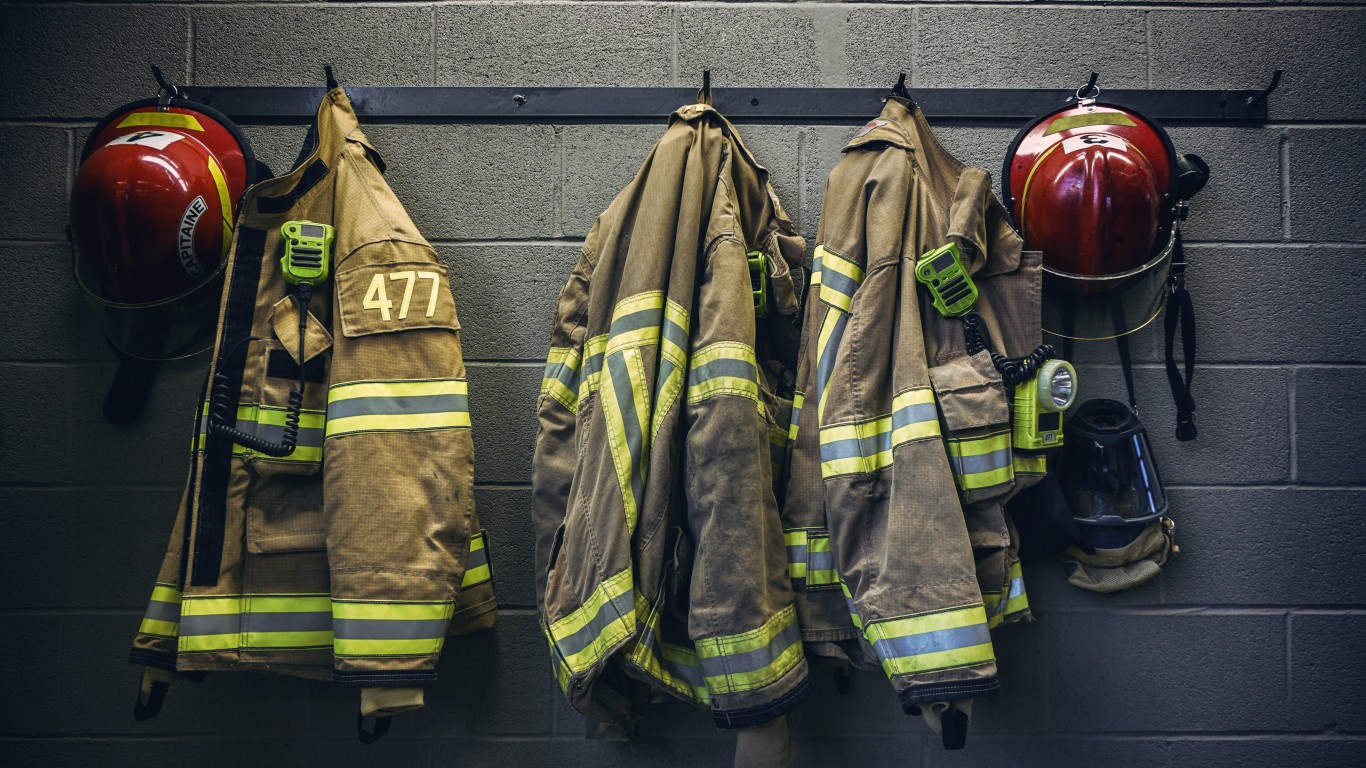
There were 2.7 million nonfatal workplace injuries and illnesses among private-industry employees in 2020, a drop of 5.7% from 2.8 million in 2019, the Bureau of Labor Statistics reported in November. The estimates, complicated by the COVID-19 pandemic, came from the Survey of Occupational Injuries and Illnesses.
Even though ours has become a service-oriented economy where the workplace is perceived to be safe, nonfatal injuries such as sprains, lacerations, chemical burns, and bone fractures as well illnesses occur in many jobs. They can be caused by transportation incidents, violence, exposure to materials, slips and falls, contact with equipment, fires, and more – and they often require time away from work. (With the recent Great Resignation, some people quit altogether. This is the industry people are quitting the fastest.)
To determine the workers who needed the most time off for injury and illness in 2020, 24/7 Wall St. reviewed U.S. Bureau of Labor Statistics report Injuries, Illnesses, and Fatalities. Occupations were ranked by the incidence rate of nonfatal occupational injuries and illnesses involving days away from work per 10,000 full-time equivalent workers. Employment and wage data also came from the BLS. Miscellaneous occupations were not considered.
The pandemic has affected the results. Total reported illness cases more than quadrupled in 2020 to 544,600 cases, up from 127,200 in 2019. This was driven by a 4,000% spike in employer-reported respiratory illness cases to 428,700 in 2020, up from 10,800 in 2019.
Over the same period, the BLS said the rate of illness cases soared to 55.9 cases per 10,000 full-time equivalent workers from 12.4 cases per 10,000. The increase was driven by the surge in the respiratory illness rate, which rose to 44.0 cases per 10,000 full-time equivalent workers from 1.1 cases per 10,000.
Because of the spike in respiratory illness related to the pandemic, health care-related jobs dominate the list of workers who needed the most time off work for illness or injuries in 2020. Law enforcement-related employees such as jailers are also represented. At-risk jobs such as welders and brazers and metal and plastics workers also appear on the list. (Find out how long the typical workweek is around the world.)
Athletes and sports competitors, which rank third on the list, are among the higher-paid workers on the list. Many of those who needed the most time off work for illness or injuries were not as well paid, including nursing assistants, orderlies, and maids and housekeeping cleaners.
Click here to see the jobs where people needed the most time off in 2020

27. Recreational therapists
> Rate of occupational injury and illness: 401.0 per 10,000 workers
> Total cases: 390
> Total full-time workers: 20,080
> Annual median wage: $51,260
[in-text-ad]

26. Medical and health services managers
> Rate of occupational injury and illness: 402.5 per 10,000 workers
> Total cases: 12,800
> Total full-time workers: 402,540
> Annual median wage: $118,800

25. Other healthcare practitioners and technical occupations
> Rate of occupational injury and illness: 411.5 per 10,000 workers
> Total cases: 2,820
> Total full-time workers: 106,380
> Annual median wage: $59,280

24. Maids and housekeeping cleaners
> Rate of occupational injury and illness: 415.0 per 10,000 workers
> Total cases: 22,840
> Total full-time workers: 795,590
> Annual median wage: $28,010
[in-text-ad-2]

23. Home appliance repairers
> Rate of occupational injury and illness: 416.9 per 10,000 workers
> Total cases: 1,000
> Total full-time workers: 27,640
> Annual median wage: $43,810

22. Animal caretakers
> Rate of occupational injury and illness: 421.5 per 10,000 workers
> Total cases: 5,290
> Total full-time workers: 193,660
> Annual median wage: $28,380
[in-text-ad]

21. Occupational therapy assistants
> Rate of occupational injury and illness: 452.1 per 10,000 workers
> Total cases: 1,200
> Total full-time workers: 42,750
> Annual median wage: $63,420

20. Aircraft cargo handling supervisors
> Rate of occupational injury and illness: 465.7 per 10,000 workers
> Total cases: 390
> Total full-time workers: 10,020
> Annual median wage: $59,620

19. Occupational therapy assistants and aides
> Rate of occupational injury and illness: 513.5 per 10,000 workers
> Total cases: 1,550
> Total full-time workers: 48,380
> Annual median wage: $60,010
[in-text-ad-2]

18. First-line supervisors of law enforcement workers
> Rate of occupational injury and illness: 542.6 per 10,000 workers
> Total cases: 170
> Total full-time workers: 175,730
> Annual median wage: $88,190

17. Emergency medical technicians and paramedics
> Rate of occupational injury and illness: 554.2 per 10,000 workers
> Total cases: 7,740
> Total full-time workers: 257,700
> Annual median wage: $40,370
[in-text-ad]

16. Miscellaneous production workers
> Rate of occupational injury and illness: 566.8 per 10,000 workers
> Total cases: 30,010
> Total full-time workers: 638,030
> Annual median wage: $35,660

15. Law enforcement workers
> Rate of occupational injury and illness: 584.2 per 10,000 workers
> Total cases: 1,460
> Total full-time workers: 1,203,450
> Annual median wage: $65,240

14. Pile driver operators
> Rate of occupational injury and illness: 585.8 per 10,000 workers
> Total cases: 190
> Total full-time workers: 3,820
> Annual median wage: $71,880
[in-text-ad-2]

13. Licensed practical and licensed vocational nurses
> Rate of occupational injury and illness: 608.4 per 10,000 workers
> Total cases: 29,230
> Total full-time workers: 676,440
> Annual median wage: $50,090

12. Bailiffs, correctional officers, and jailers
> Rate of occupational injury and illness: 682.9 per 10,000 workers
> Total cases: 1,260
> Total full-time workers: 423,980
> Annual median wage: $52,310
[in-text-ad]

11. Correctional officers and jailers
> Rate of occupational injury and illness: 688.1 per 10,000 workers
> Total cases: 1,260
> Total full-time workers: 405,870
> Annual median wage: $52,340

10. Psychiatric aides
> Rate of occupational injury and illness: 771.9 per 10,000 workers
> Total cases: 1,250
> Total full-time workers: 51,550
> Annual median wage: $33,300

9. Miscellaneous metal workers and plastic workers
> Rate of occupational injury and illness: 831.9 per 10,000 workers
> Total cases: 6,740
> Total full-time workers: 89,810
> Annual median wage: $40,060
[in-text-ad-2]

8. Orderlies
> Rate of occupational injury and illness: 887.8 per 10,000 workers
> Total cases: 2,590
> Total full-time workers: 43,570
> Annual median wage: $31,780

7. Psychiatric technicians
> Rate of occupational injury and illness: 941.8 per 10,000 workers
> Total cases: 4,460
> Total full-time workers: 85,330
> Annual median wage: $38,080
[in-text-ad]

6. Occupational therapy aides
> Rate of occupational injury and illness: 975.0 per 10,000 workers
> Total cases: 350
> Total full-time workers: 5,630
> Annual median wage: $34,160

5. Nursing assistants, orderlies, and psychiatric aides
> Rate of occupational injury and illness: 1,015.7 per 10,000 workers
> Total cases: 100,310
> Total full-time workers: 1,466,170
> Annual median wage: $32,090

4. Nursing assistants
> Rate of occupational injury and illness: 1,023.8 per 10,000 workers
> Total cases: 96,480
> Total full-time workers: 1,371,050
> Annual median wage: $32,050
[in-text-ad-2]

3. Athletes and sports competitors
> Rate of occupational injury and illness: 1,280.5 per 10,000 workers
> Total cases: 920
> Total full-time workers: 8,380
> Annual median wage: $94,740

2. Welding, soldering, and brazing machine setters, operators, and tenders
> Rate of occupational injury and illness: 1,337.6 per 10,000 workers
> Total cases: 4,130
> Total full-time workers: 33,150
> Annual median wage: $41,320
[in-text-ad]

1. Dietetic technicians
> Rate of occupational injury and illness: 3,199.3 per 10,000 workers
> Total cases: 5,850
> Total full-time workers: 26,430
> Annual median wage: $32,920
100 Million Americans Are Missing This Crucial Retirement Tool
The thought of burdening your family with a financial disaster is most Americans’ nightmare. However, recent studies show that over 100 million Americans still don’t have proper life insurance in the event they pass away.
Life insurance can bring peace of mind – ensuring your loved ones are safeguarded against unforeseen expenses and debts. With premiums often lower than expected and a variety of plans tailored to different life stages and health conditions, securing a policy is more accessible than ever.
A quick, no-obligation quote can provide valuable insight into what’s available and what might best suit your family’s needs. Life insurance is a simple step you can take today to help secure peace of mind for your loved ones tomorrow.
Click here to learn how to get a quote in just a few minutes.
Thank you for reading! Have some feedback for us?
Contact the 24/7 Wall St. editorial team.
 24/7 Wall St.
24/7 Wall St. 24/7 Wall St.
24/7 Wall St. 24/7 Wall St.
24/7 Wall St. 24/7 Wall St.
24/7 Wall St.


